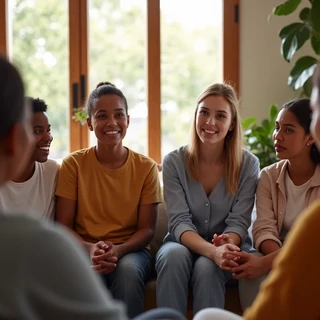Understanding Teen Anxiety During the Coronavirus Pandemic

The coronavirus pandemic has brought unprecedented challenges, particularly for teenagers. Anxiety and stress have become common as teens navigate changes in their routines, limited social interactions, and uncertainty about the future. Research shows that prolonged exposure to stressful situations can exacerbate mental health issues, making it crucial for parents and caregivers to address these concerns proactively.
Teens are especially vulnerable because they are at a developmental stage where peer relationships and independence are vital. The pandemic disrupted these aspects, leading to heightened anxiety levels. Additionally, media consumption plays a significant role in amplifying stress. Constant updates about infection rates and worst-case scenarios can overwhelm even the most resilient teens.
Understanding these dynamics is the first step in helping teens cope. By recognizing how the pandemic uniquely impacts them, parents can implement strategies to reduce anxiety and foster resilience. This article explores five ways to help teens manage anxiety about the coronavirus while offering practical insights into managing ADHD anxiety and social anxiety during these challenging times.
Practical Tips to Manage Anxiety and Stress
Limit Media Consumption: Encourage Media Distancing for Anxious Teens
One of the most effective ways to help teens manage anxiety about the coronavirus is by encouraging “”media distancing.”” Consuming excessive news or social media updates can trigger unnecessary worry and panic. Experts recommend setting boundaries around screen time to create a healthier mental environment. For instance, limiting exposure to pandemic-related content can prevent teens from spiraling into anxious thoughts.
Parents should monitor their teens’ media habits and gently guide them toward more balanced consumption. Instead of constantly checking updates, encourage teens to rely on trusted sources like the CDC or WHO for accurate information. This approach not only reduces anxiety but also helps teens develop critical thinking skills when evaluating news.
Address Extremes: Over-Consumption vs. Avoidance and Thought Suppression
While some teens may over-consume media, others might avoid it entirely, leading to thought suppression. Both extremes can be harmful. Over-consumption often results in compulsive behaviors, such as repeatedly checking infection rates or death tolls. On the other hand, avoidance can make teens feel disconnected and ill-prepared for reality.
To address these extremes, parents can introduce mini-exposures. This technique involves gradually exposing teens to small amounts of pandemic-related information in a controlled manner. For example, discussing one reliable news article per day can help teens process information without becoming overwhelmed. BrainTalking offers resources on intrusive thoughts and thought suppression, which can be valuable tools for families navigating these challenges.
Mini Exposures: Habituate the Mind to Reduce Intrusive Thoughts
Mini exposures are a powerful strategy for managing anxiety. By habituating the mind to specific triggers, teens can reduce the intensity of their intrusive thoughts. For instance, if a teen feels anxious about hearing terms like “”coronavirus”” or “”pandemic,”” introducing these words in casual conversations can desensitize them over time.
This method works best when combined with relaxation techniques, such as deep breathing or mindfulness exercises. Parents can practice these techniques alongside their teens to create a supportive environment. Incorporating these practices into daily routines can significantly improve teens’ ability to manage stress and anxiety effectively.
Establishing Healthy Family Habits
Implement a “”News Moratorium”” Before Bedtime (At Least 60 Minutes)
Creating a “”news moratorium”” before bedtime is essential for promoting restful sleep and reducing anxiety. Experts suggest turning off all devices at least 60 minutes before bed to allow the mind to unwind. Instead of scrolling through social media or watching the news, encourage teens to engage in calming activities like reading, journaling, or talking with family members.
This practice not only improves sleep quality but also strengthens family bonds. By prioritizing meaningful interactions over screen time, families can foster a sense of connection and security during uncertain times. BrainTalking emphasizes the importance of healthy sleep habits as part of overall mental well-being.
Family Culture: Creating Healthy Tech Habits Together
Establishing a family culture around technology use can benefit everyone. Parents can lead by example by setting boundaries for their own screen time and encouraging teens to follow suit. For instance, designating tech-free hours or zones in the house can promote healthier habits.
Collaborative efforts, such as turning off Wi-Fi signals after a certain time, can reinforce these boundaries. By involving teens in decision-making, parents empower them to take ownership of their tech habits. This collaborative approach fosters mutual respect and accountability within the family.
Setting Technology Timers and Boundaries
Technology timers are an excellent tool for managing screen time effectively. Most smartphones and tablets have built-in features that allow users to set usage limits. Parents can work with their teens to establish reasonable boundaries, such as limiting social media use to specific hours of the day.
These tools not only help reduce anxiety but also encourage teens to engage in offline activities. Whether it’s pursuing a hobby, exercising, or spending time outdoors, balancing screen time with real-world experiences is key to managing stress and promoting overall well-being.
How to Manage ADHD Anxiety During COVID-19
Impact of Routine Changes on Teens with ADHD
Teens with ADHD often struggle with sudden changes in routine, making the pandemic particularly challenging. Disruptions to school schedules, extracurricular activities, and social interactions can exacerbate symptoms of anxiety and stress. Maintaining structure is crucial for managing ADHD anxiety during these times.
Parents can help by creating a consistent daily schedule that includes designated times for schoolwork, exercise, meals, and relaxation. Visual aids, such as calendars or checklists, can be invaluable tools for keeping teens organized and focused. BrainTalking provides additional resources on managing ADHD-related challenges, including tips to manage anxiety and stress.
Strategies for Maintaining Structure and Reducing Chaos
Structure is key to reducing chaos and fostering a sense of stability. Parents can implement strategies such as breaking tasks into smaller, manageable steps and setting clear expectations. Providing positive reinforcement for completed tasks can motivate teens and boost their confidence.
Incorporating physical activity into the daily routine is another effective strategy. Exercise releases endorphins, which can improve mood and reduce anxiety. Whether it’s a family walk, yoga session, or dance party, finding fun ways to stay active can make a significant difference.
Utilizing Online Resources and Support Groups
Online resources and support groups can provide valuable assistance for teens with ADHD. Many organizations offer virtual meetings, webinars, and educational materials designed to help families navigate the unique challenges of the pandemic. Connecting with others who share similar experiences can reduce feelings of isolation and provide practical advice.
BrainTalking encourages parents to explore these resources and involve their teens in the process. By actively participating in online communities, teens can build resilience and develop coping strategies tailored to their needs.

Ways to Manage Social Anxiety in Isolation
Encouraging Virtual Social Interaction with Friends and Family
Social isolation can intensify feelings of loneliness and anxiety, especially for teens prone to social anxiety. Encouraging virtual interactions can help bridge the gap and maintain connections. Platforms like Zoom, FaceTime, or Skype offer opportunities for teens to stay in touch with friends and loved ones.
Parents can facilitate virtual hangouts by organizing game nights, movie watch parties, or group chats. These activities not only combat loneliness but also provide a sense of normalcy during uncertain times. BrainTalking highlights the importance of staying connected as a way to manage social anxiety effectively.

Finding Alternative Ways to Connect and Combat Loneliness
In addition to virtual interactions, teens can explore alternative ways to connect with others. Writing letters, creating art projects, or participating in online forums can foster meaningful connections. These activities allow teens to express themselves creatively while building relationships with peers who share similar interests.
Encouraging teens to volunteer virtually or contribute to community projects can also reduce feelings of isolation. Acts of kindness and service promote a sense of purpose and belonging, which are essential for mental well-being.
Activities to Promote Well-Being and Reduce Social Anxiety
Engaging in activities that promote well-being can significantly reduce social anxiety. Mindfulness practices, such as meditation or yoga, can help teens stay grounded and present. Creative outlets like painting, writing, or playing music offer therapeutic benefits and provide a healthy way to process emotions.
Physical activity is another powerful tool for managing anxiety. Whether it’s dancing, hiking, or practicing martial arts, movement can release tension and improve mood. Parents can support their teens by providing access to these activities and participating alongside them when possible.
Talking to Teens About the Virus
Age-Appropriate Conversation: Respect Their Wisdom and Ability to Handle Life Complexities
When discussing the coronavirus with teens, it’s important to respect their ability to understand complex topics. Start by asking what they already know and addressing any misconceptions. Provide age-appropriate information that answers their questions without overwhelming them.
Avoid using alarmist language or focusing on worst-case scenarios. Instead, emphasize facts and reassure them that measures are in place to keep people safe. BrainTalking recommends tailoring conversations to each teen’s unique needs and concerns.
Provide Factual Information Without Exaggeration or Alarming Predictions
Providing factual information is key to reducing anxiety. Use reliable sources like the CDC or WHO to ensure accuracy. Explain concepts in simple terms and relate statistics to everyday experiences. For example, comparing infection rates to attendance at a football game can make percentages more relatable.
Reassure teens that while the virus poses risks, the likelihood of severe outcomes is low for most individuals. Highlighting positive developments, such as vaccine progress or community support efforts, can instill hope and optimism.
Reassure and Provide Current, Realistic Data (Avoid Worst-Case Scenarios)
Reassurance is critical when talking to teens about the pandemic. Focus on current, realistic data rather than hypothetical worst-case scenarios. Emphasize the importance of following safety guidelines, such as wearing masks and practicing social distancing, to protect themselves and others.
Encourage teens to ask questions and express their feelings openly. Listening attentively and validating their concerns can strengthen trust and communication. BrainTalking emphasizes the value of open dialogue in helping teens navigate anxiety and uncertainty.
Takeaways: Actionable Steps for Parents and Teens
- Encourage media distancing to reduce anxiety triggered by excessive news consumption.
- Address extremes of over-consumption and avoidance through mini exposures.
- Implement a “”news moratorium”” at least 60 minutes before bedtime.
- Create a family culture of healthy tech habits by setting timers and boundaries.
- Maintain structure and routine to manage ADHD anxiety effectively.
- Foster virtual social interactions to combat loneliness and social anxiety.
- Engage in activities that promote well-being, such as mindfulness and exercise.
- Have age-appropriate conversations with teens about the virus, focusing on facts and reassurance.
Q&A Section: Common Questions About Managing Teen Anxiety

Q: How can I help my teen manage anxiety without making them feel overwhelmed?




